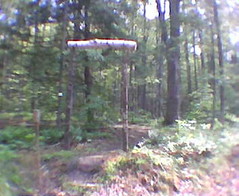Mortises and Tenons
 This weekend I tried my hand at a little mortise and tenon woodwork. I went down to the hardware store and picked up a cheap chisel, mallet and a handsaw, then headed into the woods and sawed a couple ten foot lengths of fallen white pine (I think) and a six foot piece of birch. I lugged them down to the road, flipping them end over end. Not having ever tried creating anything with a chisel before, I was pleased to find that it wasn't very hard. I made an initial cut with the handsaw 3 inches from the end of the log and then chiseled to the cut creating a flat side. I rotated the log and repeated. In a few minutes I had a 2x2x3 inch tenon, pretty neatly square without much trouble. Never having tried this before I was pleased.
This weekend I tried my hand at a little mortise and tenon woodwork. I went down to the hardware store and picked up a cheap chisel, mallet and a handsaw, then headed into the woods and sawed a couple ten foot lengths of fallen white pine (I think) and a six foot piece of birch. I lugged them down to the road, flipping them end over end. Not having ever tried creating anything with a chisel before, I was pleased to find that it wasn't very hard. I made an initial cut with the handsaw 3 inches from the end of the log and then chiseled to the cut creating a flat side. I rotated the log and repeated. In a few minutes I had a 2x2x3 inch tenon, pretty neatly square without much trouble. Never having tried this before I was pleased.

I repeated this on the other post and then took up the birch creating the mortises to receive the tenons. This proved a little more difficult since I was cutting into a log and because the birch seems quite a bit harder than the pine. Even so, it didn't take too long.
The next morning, Ribbon and I dug post holes and raised the gate. The birch simply sits on the tenons, so it's not really a complete joint because it doesn't have pegs, but, hey, it's just a gate.


2 Comments:
Matteo, very impresive! I wonder how easy hemlock will be to work with? Peat
thanks! from what i've read hemlock is one of the easiest woods to work when green. the white pine pictured in this post was really easy to work. the one problem with hemlock is shake, a condition where the corners of a beam or post break off along the rings of the tree. it slightly weakens beams, but is more of an irritation than a structural issue, from what i've read. hemlock is also splintery.
Post a Comment
<< Home